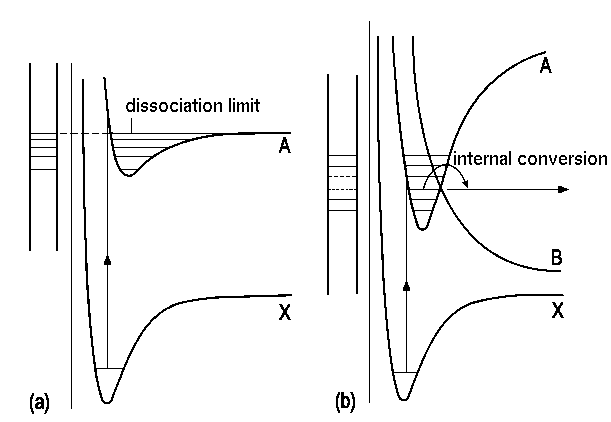Dissociation and Predissociation
![]()
If excitation transfers a molecule in a state containing more energy than the separated components, dissociation takes place
In some spectra, the line structure disappears already for energies below the dissociation limit but reappears again at higher energies. This finding is explained by a phenomenon called predissociation
 |
| Fig. 1
a)In cases where an electronic excitation passes an amount of energy that lifts the molecule in a state above the highest vibrational levels, dissociation occurs. The respective spectrum displays a blurred zone beyond the so-called dissociation limit. b)Predissociation is found for molecules where potential curves of a bound and an unbound state cross each other. An inferior amount of energy lifts the molecule in a state where the electrons can rearrange to an unbound state (internal conversion). In the spectral range that corresponds to these energies, a blurred zone appears. Beyond this zone, there are again discrete lines. |
Predissociation is connected with an internal conversion from an excited state A towards a dissociative state B. We assume some relatedness between the vibrational states closely above the level of intersection and the translational motion during dissociation. These circumstances allow a separation of a molecule via state B without supplying the energy of dissociation for state A. Note that, in the range beyond the blurred caused by predissociation, discrete lines are found. An interpretation would be that for higher vibrational states, a conversion towards state B is excluded again.
Sometimes, predissociation is introduced by additional external factors. For example, we can imagine a molecule to be pushed from state A to state B when colliding with another. Alternatively, under the influence of a field, selection rules are sometimes overriden. In such cases, we speak of collision- or field- induced predissociation.
![]()
Auf diesem Webangebot gilt die Datenschutzerklärung der TU Braunschweig mit Ausnahme der Abschnitte VI, VII und VIII.